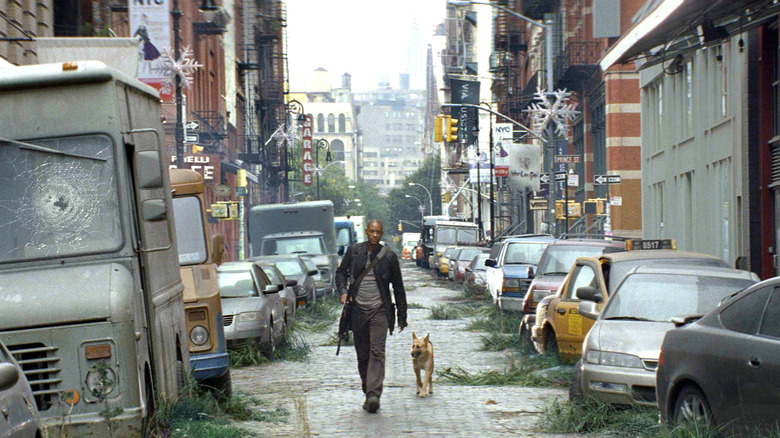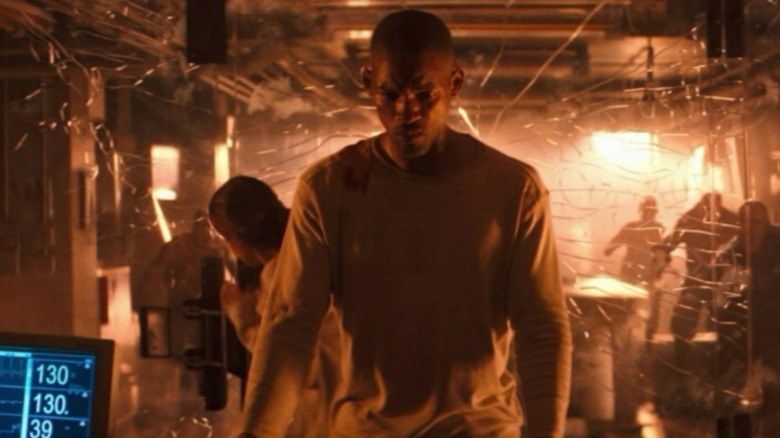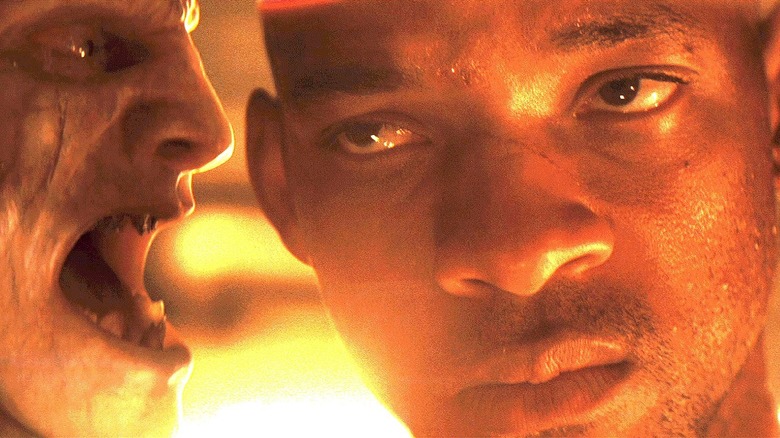I Am Legend's Alternate Ending Changes Everything
Remember a time before "The Walking Dead" (and its never-ending assortment of spin-offs) when post-apocalyptic stories hadn't yet become an overused, played-out staple? 2007 was a very different year, to say the least. Expectations were high when the news initially broke that Will Smith, one of the world's biggest movie stars and in the prime of his career, would be leading a new movie based on author Richard Matheson's widely influential 1954 novel, "I Am Legend." That hype translated to strong box office returns, even if Smith himself had higher expectations. The story follows Robert Neville, possibly the last surviving human on Earth after a pandemic has transformed the rest of humanity into what seems like soulless zombies, but that's where the similarities between the source material and the movie adaptation end.
For one thing, the "zombies" in the original novel ... weren't ever really zombies in the first place. Matheson repeatedly refers to the fearsome creatures as vampires in his book, avoiding garlic and sunlight as much as possible, nursing an insatiable need to drink blood, and possessing a telltale weakness for wooden stakes. Otherwise, they're largely indistinguishable in appearance from normal humans. The chilling description of supernatural beings who retain the intelligence and memories of their former lives is a far cry from the mindless "Darkseekers" of the film — even setting aside the divisive choice to render such creatures in CGI. Directed by Francis Lawrence and written by Mark Protosevich and Akiva Goldsman, "I Am Legend" portrays Will Smith's version of Neville with more of a focus on typical blockbuster action. He's still a brilliant survivalist bent on finding a cure for the zombie disease at all costs, but you can't miss how the story kicks off with a thrilling sequence where he hunts deer in his flashy Ford Mustang with his trusty canine companion before coming face-to-face with a wild pack of lions, long-escaped from the Bronx Zoo. Spoiler alert: that's not quite the same tone as the quieter, more cerebral original novel.
Adaptations inevitably take artistic license when translating stories to a different medium altogether, as has been the case for decades, but did you know "I Am Legend" could've remained much more faithful to Matheson's novel? An alternate ending, as it turns out, might've changed everything.
Two is better than one
The recent news that Will Smith will be making his grand return to the "I Am Legend" world for a sequel, while exciting, inevitably raised certain questions. Mainly, wouldn't the canonical ending of the original movie make Smith's return a little tricky?
After following Robert Neville's desperate attempts to find a cure for the zombie virus while maintaining his sanity in the face of unimaginable loneliness, the unexpected arrival of fellow survivors Anna (Alice Braga) and Ethan (Charlie Tahan) raises the stakes for the final stretch of the movie. Inevitably, the appearance of zombies at Neville's door leads to an all-out fight for survival. The intense firefight ends with the three humans trapped in his basement lab, which currently holds a captured zombie "patient" that Neville has been testing cures on for much of the movie.
In the theatrical cut, Neville realizes that the serum is actually working on the Darkseeker. The unstoppable horde of attacking zombies, however, leaves him with little choice. Entrusting the invaluable cure to Anna, Neville picks up a grenade and sacrifices himself in a blaze of glory to give the others a chance to escape and, someday, save the world. Though a typically heroic climax by the standards of Hollywood, many critics at the time called out this ending for taking a disappointingly obvious and straightforward approach to such nuanced, thought-provoking source material. Luckily, the home release provided an opportunity to make amends, as the special features included a previously-unseen alternate ending that reframed our perceptions of the entire movie.
The new ending picks up in the basement lab and sees Neville come to a shocking realization about his supposed enemies. To his amazement, the zombie leader only attacked in order to rescue his mate — the female Darkseeker that Neville essentially kidnapped earlier in the film. With this evidence flipping his (and our) assumptions of these creatures completely upside down, our hero foregoes any further violence and simply returns the Darkseeker to her people. In this instance, the movie ends with our trio of human survivors, armed with this game-changing knowledge, escaping from the ruins of Manhattan and searching for more survivors scattered throughout the world.
Convention vs complexity
Needless to say, the alternate ending of "I Am Legend" brings the adaptation much closer to the original novel; if not in the exact details, then at least in spirit.
If you've read Richard Matheson's novel — and for those of you who haven't, you absolutely should — then you know that his depiction of the vampires served an immensely important purpose. Like the absolute best examples of sci-fi, "I Am Legend" ultimately reveals itself to be a parable about the human condition. Specifically, the main takeaway involves our inclination towards distrust and suspicion of those we've historically perceived as "others" and less-than ourselves. After years of viewing the vampires as beasts who need to be cured or, failing that, eradicated completely, Neville is ultimately taken prisoner by the vampires and learns the profound error of his ways. A glimpse of their downright domestic lifestyle proves that these transformed creatures had only ever sought to establish a new society of their own. The monstrous Neville, in their eyes, was always the malevolent "legend" of myth that kept them awake at night (well, make that day — you know, since they're vampires and all).
This complex and utterly thought-provoking notion forces readers to reevaluate our worldviews and inherent biases, as Matheson uses such an exaggerated cautionary tale to teach us valuable lessons that ought to be applied in everyday life. Although the much more conventional ending of the film adaptation fails to reach the exact same levels of profundity, the alternate ending at least steers much closer to the original intent behind the classic story. As black-and-white as the narratives we write for ourselves may seem, some much-needed introspection may just reveal that we were the villains of our own story all along.


